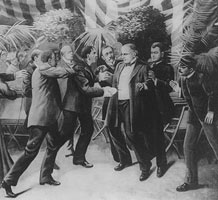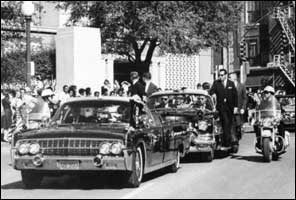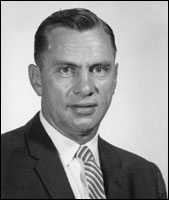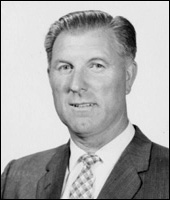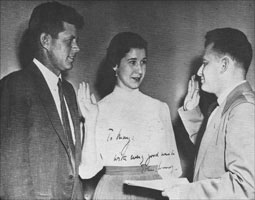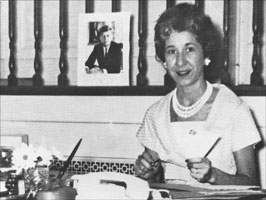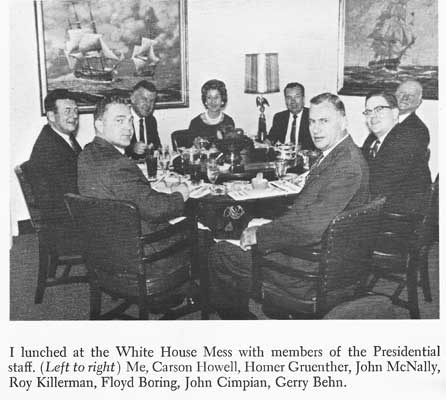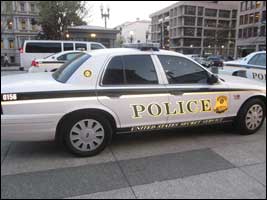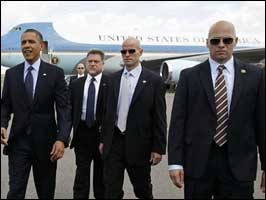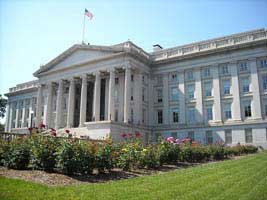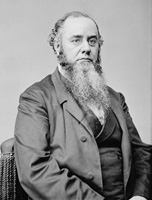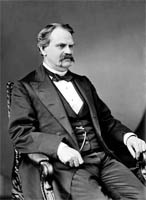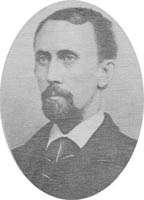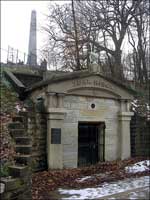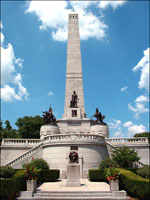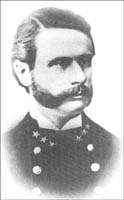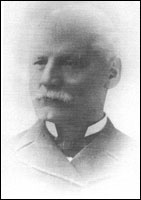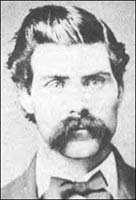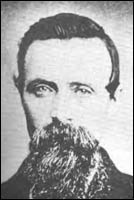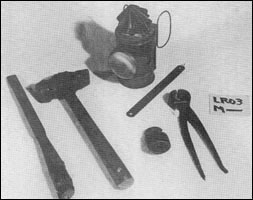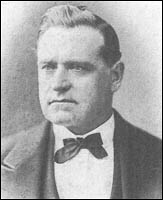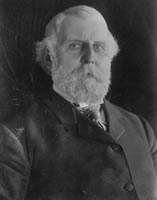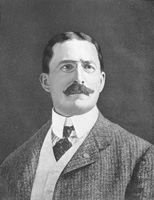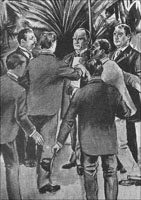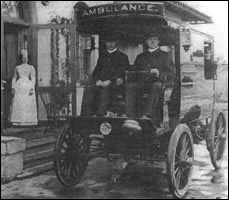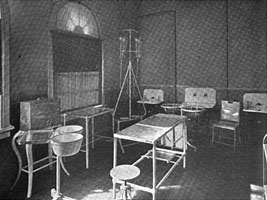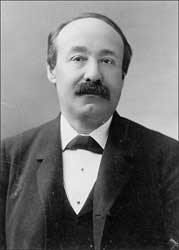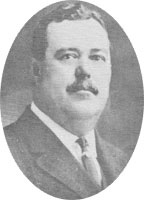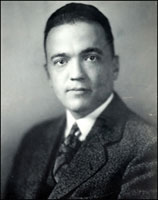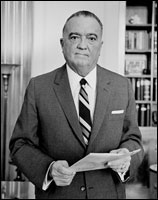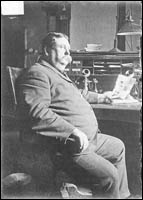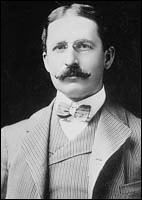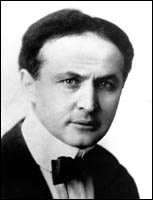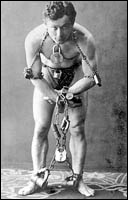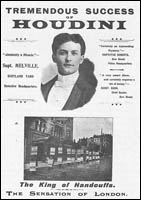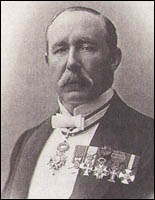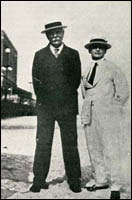U.S. citizens can sleep soundly at night knowing that our President is "protected" by the U.S. branch of the British Secret Service. With over 450 years of experience, the British Secret Service is prepared to react immediately to any threat to our President. The first President to have a Secret Service Praetorian Guard was President McKinley in 1898....3 years later he was assassinated.
President Kennedy was "protected" by the Secret Service in Dallas, Texas, on Nov 22, 1963. Not all the agents know that they are working for the British Secret Service. Just before the assassination of President Kennedy, his usual driver, Thomas Shipman, died suddenly of a "heart attack" and he was replaced by special agent Bill Greer.
All the shots that killed the President came from the front of the limousine, while the President's wife scrambled desperately to the back to get away from the gunmen in the front. The entire Dallas trip was arranged by the U.S. branch of the British Secret Service . . . down to the smallest details. According to best-selling Kennedy assassination author William Manchester, Greer actually admitted to the murder:
Greer's crying and weeping after the deadly deed was done wouldn't bring the President back. Assassinations are usually carried out by people who are very familiar with the victim. Caesar was assassinated by his close friends, and President Lincoln knew John Wilkes Booth very well.
Soon after the assassination,
after years of devoted service, Jackie dropped her suddenly, and no
longer required her services. Author William Manchester never even bothered
to consult her.
No publisher in "the home of the brave" would dare tell the truth about the assassination. Mary did it in the least hazardous way: She published a photo of Roy Killerman in her 1969 book My Life With Jackie Kennedy.
There are 3 main reasons why the British Secret Service opened up a U.S. branch to "protect" our Presidents:
These 3 men dealt a mighty blow to the British Empire and they are determined that no such men would ever occupy the White House again. U.S. citizens can also sleep soundly because the Treasury Department is also "protected" by the U.S. branch of the British Secret Service.
There is a close association between the Treasury and the White House. The President cannot say 'bomb's away" if no money is available to make the bombs....Napoleon said "an army marches on its stomach," and even spies and the men in the Pentagon have to eat. The U.S. branch of the British Secret Service actually opened during the Civil War.
Here is an excerpt from an authorized history of the Secret Service: During the Civil War Wood's personal friend, Edwin M. Stanton, Secretary of War in Abraham Lincoln's Cabinet, hired Wood to uncover thieving contractors seeking to defraud the Government, and to detect and arrest other criminals preying upon Uncle Sam's urgent wartime needs. Stanton and Wood had first met in 1854 when Stanton, a practicing attorney, represented a client who was being sued by Cyrus H. McCormick, inventor of the reaper. The whole case rested on the shape of a divider blade on a reaper that had originally been bought from McCormick and had been in use for 15 years. If the divider was straight, McCormick would lose the suit. If it was curved, he would win. The reaper was brought into court. The divider was straight, and McCormick lost. (Bowen & Neal, The United States Secret Service, p. 12). After the assassination, Wood's main job was to uncover the plot to assassinate the President by interrogating all the principals. Wood was sworn in as Chief of the newborn agency on July 5, 1865: He was sworn in as Chief of the U.S. Secret Service on July 5, 1865, in the office of Edward P. Jordan, Solicitor of the Treasury. Solicitor Jordan made a few brief remarks about the purposes of the new agency. "The main object," he said, "is to restore public confidence in the money of this country. Our policies and rules can take shape as your work progresses." Wood's force numbered about 30 men. Some of these were former private detectives who had worked on counterfeiting cases. Others were trusted friends or associates of Wood who had worked under his direction during the war. (Bowen & Neal, The United States Secret Service, p. 15). Charged with protecting the currency . . . not the President . . . these sleuths failed completely to notice the demonitization of silver in 1873. In the Coinage Act of 1792, Congress fixed the value of the dollar at 371.25 grains of fine silver.
The demonitization of silver put the U.S. on the gold standard and caused the Panic of 1873. On February 12, 1873, Congress revised the coinage laws. By a simple stroke of the pen, silver was assassinated. The U.S. went on the gold standard, and silver was demonetized except for payments under $5.00. A gold dollar became the unit of value, and free coinage of silver was ended. Soon after that, the entire world demonetized silver, and most nations went on a monometallic, or gold standard. The result of the demonitization of silver was a worldwide depression called the Panic of 1873. The U.S. never fully recovered from the resulting depression until 1880. Thousands of companies were bankrupted, and millions faced starvation. The Depression did not affect the U.S. branch of the British Secret Service who used the money confiscated from the counterfeiters to finance their operations.The Secret Service attempt to steal President Lincoln's body!!President Lincoln's funeral train arrived in the Illinois State Capitol on May 3, 1865. The next day his body was placed in a receiving vault in Oak Ridge Cemetery. In December 1865, his body was placed in a temporary vault in the cemetery.
In one of the most bizarre false flag incidents in U.S. history, "grave robbers" attempted to steal the body of President Lincoln and hold it for ransom. That was just a "cover story" however, as the Secret Service planned on using the body of the dead President to gain publicity for their campaign to "protect" living Presidents....The Secret Service already "protected" our currency, and they were anxious to "protect" our Presidents too!!
After Washburn resigned from his position as chief, he became chief operative in the Chicago District. He used a popular saloon called the Hub as a spying station. The other men involved were: Benjamin Boyd, James "Big Bill" Kennally, Terence Mullen, Jack Hughes, and Lewis Swegles. The Secret Service had agents everywhere in Chicago. Mullen and Hughes were the patsies or dupes, while Swegles was their liaison with the body snatchers. Of course, the Secret Service was awash in counterfeit dollars to pay their operatives.
Providentially, as Washburn and his associates waited at the tomb, one of his detectives had a trigger finger, and fired his pistol inadvertently. The shot alerted Mullen and Hughes, and they escaped:
To his great disappointment, the grave robbers had fled just before Tyrrell entered the bomb.
There was to be no banner Chicago Tribune headline blaring: SECRET SERVICE FOILS PRESIDENTIAL GRAVE ROBBERS!! This was a very big setback for the Secret Service because they were very anxious to start "protecting" living Presidents. President McKinley was assassinated after receiving Secret Service protection!!In early 1898, Secretary of the Treasury Lyman J. Gage appointed John E. Wilkie to the position of Chief of the Secret Service. Wilkie was a crime reporter for the Chicago Tribune and had just spent 5 years in London learning the tricks of the spying trade.
Wilkie, the well trained British spy, was the perfect person to head the U.S. branch of the British Secret Service:
In February 1898, the USS Maine was blown up in Havana harbor by Secret Service agents. This false flag operation triggered the Spanish-American War and the Secret Service was charged with tracking down and arresting "Spanish" spies: Wilkie's next big assignment was the result of the war between the United States and Spain, when the War Department called on the Secret Service to track down "Spanish" spies. Wilkie organized an auxiliary force of Spanish-speaking agents and stationed them at strategic points throughout the nation. (Bowen & Neal, The United States Secret Service, p. 160). One of the big benefits of the war for the U.S. branch of the British Secret Service was the making of "war hero" Teddy Roosevelt. During the war, President McKinley got many threats from "anarchists" and others opposed to the war, so a permanent bodyguard was assigned to "protect" him. On September 6, 1901, the President was in Buffalo, New York, greeting visitors at the Pan-American exhibition, when he was shot twice. 3 Secret Service agents were assigned to "protect" President McKinley in Buffalo, New York.
At the critical moment before the assassin Leon Czolgosz fired his gun, one of the agents moved to the left side of the President, thus enabling the assassin to fire 2 shots. Here is a brief report of that momentous event from Agent Don Wilkie, son of Chief John Wilkie:
After the shooting of the President, he was rushed by electric ambulance to the Pan-American Exposition hospital.
The Exposition hospital was not equipped to handle gunshot wounds but it did have a dimly lit operating room. Dr. Matthew D. Mann, a professor of Obstetrics and Gynecology, led the team of physicians operating on the President. A specialist in gunshot wounds named Dr. Roswell Park was operating on a patient in nearby Niagara Falls, but he refused to leave his patient in order to save the life of the President of the United States. Due to the timely death of the President, Roosevelt the Rebel became President. Wilkie said that the assassination was blind chance....Nothing happens in the political realm by chance . . . especially assassinations....This was a cold blooded killing by the Secret Service in order to put their man Teddy Roosevelt in the White House. In 1903, Roosevelt the Rebel caused Panama to secede from Columbia for the purpose of building a canal. The real reason for the Panama Canal was to facilitate the fast movement of BATTLESHIPS between the Atlantic and Pacific Oceans!! The FBI is a branch of the Secret Service!!Charles Joseph Bonaparte was a grandson of Jérôme Bonaparte (the youngest brother of the French emperor Napoleon I), and attorney general in the Roosevelt administration from 1906 to 1909. Bonaparte used a lawyer named Stanley Wellington Finch (1872–1951) to set up the Bureau of Inquisition, and he was the director from 1908 to 1912. Finch borrowed personnel from the Secret Service to be the first agents. Here is a report from an authorized history of the Secret Service:
The 8 spies were the nucleus of the new spying bureau.
William J. Flynn retired from the Secret Service in 1917, and 2 years later he was appointed the 4th director of the Bureau of Inquisition. This was the beginning of the "Soviet" or "Bolshevik" scare:
In 1924, J. Edgar Hoover was promoted to head the Bureau of Inquisition.
Everybody is familiar with the 5-decades career of the notorious J. Edgar Hoover. 5 Presidents trembled at the very mention of his name. Hoover had an extensive file on the personal habits of just about everybody of importance in the nation. In addition, the Internal Revenue Service augmented his files with financial and tax data. His Bureau of Inquisition was the envy of Heinrich Himmlers's SS in Germany.Harry Houdini spied for both branches of the Secret Service!!Harry Houdini worked at the U.S. and Russian branches of the British Secret Service. Houdini first received nationwide publicity for his "great escapes" in Chicago. Illinois. Lieutenant Andrew Rohan was a fixture in the Chicago Police Department and he worked closely with Chicago Tribune reporter John E. Wilkie.
In 1899, Houdini came to Chicago to demonstrate his escape artistry, and he received banner headlines in the Chicago Tribune.
Houdini's escape wizardy amazed the hundreds of people gathered to watch him:
From that initial publicity, Houdini went on to become an international star. Very few suspected him of being a British spy. In May 1900, Houdini and his wife set sail for England.
Secret Service Chief John E. Wilkie sailed for England in 1902, and then he went on to Europe, where he worked with fellow spy Houdini:
By 1900, most respectable people in Britain still regarded spies as despicable. Spying just became overt at that time. During his stay in Britain, Sir Arthur Conan Doyle became fascinated by Houdini's escape antics and they became close friends.
Houdini was an international superstar like Albert Einstein, and he knew most of his fellow spies like Charlie Chaplin, Jack London, Sarah Bernhardt, and Margery the Medium Crandon etc., etc. Houdini believed that all mediums were fakes, and all supernatural phenomenon had a natural explanation. He did not believe that demons existed, so he set out to expose all the mediums as charlatans. Houdini died and went to Hades on Reformation Day, 1926. He will never, never escape from that place. Vital links
References Bowen, Walter S. & Neal, Harry Edward. The United States Secret Service. Chilton Company Publishers, Philadelphia, 1960. Craughwell, Thomas J. Stealing Lincoln's Body. Harvard University Press, Cambridge, MASS, 2007 Cook, Andrew. M: MI5's First Spymaster. Tempus Publishing Group, Stroud, Gloucestershire, UK, 2004. (A biography of William Melville). Fred T. Newcomb & Perry Adams. Murder From Within: Lyndon's Johnson's Plot Against President Kennedy. AuthorHouse, Bloomington, IN, 2011. Gallagher, Mary Barelli. My Life With Jackie Kennedy. David McKay Company, New York, 1969. Gage, Lyman J. Memoirs of Lyman J. Gage. House of Field, Inc, New York, 1937. Harvey, William H. Coin's Financial School. Harvard University Press, Cambridge, MASS, 1963. First published in 1894. Harvey exposed the assassination of silver in 1873, Kalush, William& Sloman, Harry. The Secret Life of Houdini: The Making of America's First Superhero. Simon & Schuster, New York, 2006. Melanson, Philip H. The Secret Service: The Hidden History of an Enigmatic Agency. Carroll & Graf Publishers, New York, 2002. Morris, Edmund. Theadore Rex. Random House, New York, 2001. Manchester, William. Death of a President. Little, Brown & Company, New York, 1967. Palmara, Michael Vincent. Survivor's Guilt : the Secret Service and the Failure to Protect President Kennedy. Walterville, Oregon, 2013. Silverman, Kenneth. Houdini: The Career of Ehrich Weiss. HarperCollins Publishers, New York, 1996. Summers, Anthony. Official and Confidential: The Secret Life of J. Edgar Hoover. G.P. Putnam's Sons, New York, 1993. Weale, Adrian, Army of Evil: A History of the SS. Penguin Group. New York, 2012. Wilkie, Don. American Secret Service Agent. Frederick A. Stokes Company, New York. 1934. Copyright © 2015 by Patrick Scrivener
|
||||||||||||||||||||||||||||||||||||||||||||||||||||||||||||||||||||||||||||||||||||||||||||||||||||||||||||||||||||||||||||||||||||||||||||||||||||||
